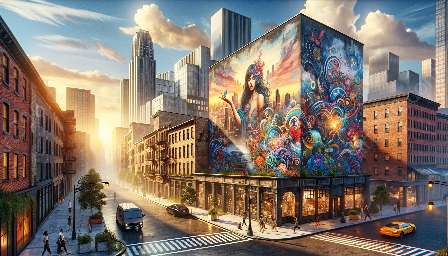Street art has become a significant player in the complex urban landscape, not only as a form of expression but also as a catalyst for change. Its role in urban revitalization and gentrification is a topic of great interest and debate, particularly in the context of its relationship with pop culture. This article aims to explore the multifaceted role of street art by examining its origins, impact, and implications for urban development.
The Origins of Street Art
Street art has its roots in the counterculture movements of the 20th century, where artists used public spaces to challenge social norms and political ideologies. Emerging from graffiti and muralism, street art has evolved into a global phenomenon, reflecting the diverse voices and experiences of urban communities. In this sense, street art serves as a medium through which marginalized groups can reclaim and redefine public spaces, contributing to a sense of identity and belonging.
Street Art as Cultural Signifier
As an integral part of pop culture, street art plays a crucial role in shaping the visual and social identity of urban environments. Murals, stencils, and installations serve as cultural signifiers, expressing the narratives, struggles, and aspirations of local communities. In doing so, street art cultivates a sense of pride and ownership, transforming neglected areas into vibrant cultural hubs. By engaging with the local context, street art reinforces the connection between art and everyday life, fostering a dialogue between residents and their environment.
Street Art as a Tool for Urban Revitalization
One of the most prominent roles of street art is its contribution to urban revitalization. Abandoned buildings, empty lots, and underutilized public spaces offer canvases for artists to breathe new life into deteriorating urban landscapes. By revitalizing these spaces with visually striking and thought-provoking artworks, street art can attract attention, foot traffic, and investment, ultimately reshaping the urban fabric. This process often leads to the creation of cultural districts, tourist attractions, and creative economies, stimulating local businesses and fostering a sense of community pride and engagement.
The Impact of Gentrification
While street art can be a force for positive change, its relationship with gentrification is complex and contentious. As urban revitalization efforts gain momentum, they can also pave the way for gentrification, resulting in the displacement of longstanding communities, rising property prices, and homogenization of local cultures. In some cases, street art becomes a tool for branding and marketing, as developers and businesses capitalize on its aesthetic appeal to attract affluent residents and tourists. Consequently, the very communities that contributed to the vibrancy and authenticity of street art are often excluded from the benefits of its commercialization.
Navigating the Intersection
To address the multifaceted relationship between street art, urban revitalization, and gentrification, it is essential to consider the perspectives of artists, residents, policymakers, and urban planners. Collaborative efforts that prioritize community engagement, affordable housing, and cultural preservation can mitigate the negative impacts of gentrification while leveraging the potential of street art as a tool for inclusive urban development. By fostering a balanced and equitable approach, street art can continue to enrich urban spaces without contributing to their displacement or erasure.
Conclusion
The intersection of street art, urban revitalization, and gentrification underscores the intricate dynamics of art, culture, and urban development. As an embodiment of pop culture, street art reflects the values, struggles, and aspirations of diverse communities, exerting a transformative influence on urban landscapes. To harness its potential for positive change, it is imperative to navigate the complex relationship between street art and gentrification, striving for inclusive and sustainable urban development that preserves the authenticity and diversity of the cities we inhabit.

